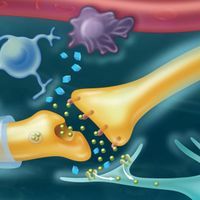Login
Subscribepain, neuroscience

When Normal Touch Becomes Painful, the Same Neurons Are Involved
Ruth Williams | Oct 10, 2018 | 4 min read
In a condition called mechanical allodynia, when everyday activities exact misery, the same neurons that ordinarily transmit normal touch are involved in feelings of pain.

Image of the Day: Pain or O-Face?
Jef Akst | Oct 10, 2018 | 1 min read
Expressions of pain and orgasm are distinguishable, study finds.

Synthetic Botox Treats Chronic Pain in Mice
Abby Olena, PhD | Jul 18, 2018 | 3 min read
Researchers silence pain neurons in the mouse spinal cord with injections of botulinum toxins modified to bind to the neurons’ receptors.

Why Swearing and Pain Go Hand in Hand
Emma Byrne | Jan 1, 2018 | 3 min read
Screaming obscenities when you stub your toe makes perfect biological sense.

Annina Schmid Dissects Nerve Disorders
Catherine Offord | Jan 1, 2018 | 2 min read
A background in physiotherapy helps the Oxford-based researcher mix basic science with clinical work to better understand pain stemming from nerve compression.

Glial Ties to Persistent Pain
Mark R. Hutchinson | Jan 1, 2018 | 10 min read
Immune-like cells in the central nervous system are now recognized as key participants in the creation and maintenance of persistent pain.

Targeting Sodium Channels for Pain Relief
Catherine Offord | Jan 1, 2018 | 10+ min read
The race to develop analgesic drugs that inhibit sodium channel NaV1.7 is revealing a complex sensory role for the protein.

Mothers Are Hard-Wired to Respond Similarly to Infant Cries Across Cultures
Shawna Williams | Jan 1, 2018 | 3 min read
Researchers find consistent behaviors and brain activity in an international study.

Sex Differences in Opioid Analgesia: A Complicated Picture
Catherine Offord | Jan 1, 2018 | 5 min read
Researchers are beginning to tease apart the mechanisms underlying differences in how males and females respond to powerful painkillers.

Contributors
Jef Akst and Katarina Zimmer | Jan 1, 2018 | 3 min read
Meet some of the people featured in the January 2018 issue of The Scientist.

Frog Skin Yields Potent Painkillers, but None Clinic Ready
Shawna Williams | Jan 1, 2018 | 2 min read
Decades after their discovery by bioprospectors, amphibian-derived analgesics continue to attract scientific attention.

Sourcing Painkillers from Scorpions’ Stings
Abby Olena, PhD | Jan 1, 2018 | 2 min read
Compounds in the arachnids’ venom interact with ion channels to both cause and block pain.

Toxin from a Dangerous Fish Delicacy
Kerry Grens | Jan 1, 2018 | 2 min read
In tiny doses, the pufferfish’s tetrodotoxin can be turned into a pain-relieving ion channel blocker.

Mining Spider Toxins for Analgesic Clues
Catherine Offord | Jan 1, 2018 | 2 min read
Arachnids harbor a plentiful array of molecules that target mammalian pain receptors.

Researchers Mine Centipede Toxins for Analgesics
Catherine Offord | Jan 1, 2018 | 1 min read
Venomous centipedes may harbor a clue to the creation of a successful pain-killing compound for humans.

Novel Analgesics at a Snail’s Pace
Bob Grant | Jan 1, 2018 | 3 min read
Studying cone snail venom has yielded novel pain pathways, but the peptides that function as toxins are difficult to translate into drugs.

Linoleic Acid Derivatives Potentially Mediate Pain and Itch in the Skin
Katarina Zimmer | Jan 1, 2018 | 2 min read
Researchers uncover a family of compounds that may be involved in pain transmission.

Snake Venoms Cause and Block Pain
Kerry Grens | Jan 1, 2018 | 2 min read
Painful snake bites may hold clues to developing analgesic drugs.

Infographic: Two Pain Paths Diverge in the Body
Mark R. Hutchinson | Dec 31, 2017 | 2 min read
The acute pain that results from injury or disease is very different from chronic pain.
